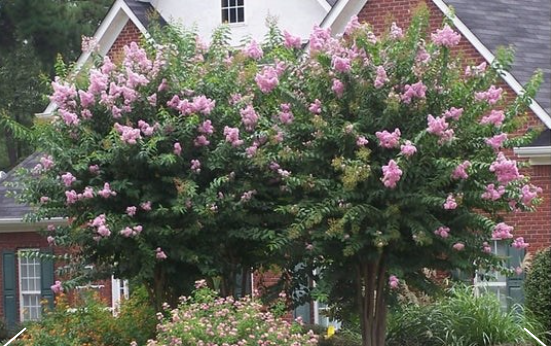The Muskogee Crape Myrtle, also known as Lagerstroemia ‘Muskogee’, is a popular cultivar of the Crape Myrtle tree. It was developed by the United States National Arboretum in Washington D.C and given the name of the native American Indian tribe ‘Muskogee.’It is a hybrid of Lagerstroemia fauriei and Lagerstroemia indica.
The breeding work that led to the creation of the Muskogee Crape Myrtle was aimed at producing a Crape Myrtle with improved resistance to powdery mildew, a common fungal disease that affects many Crape Myrtle varieties. The hybridization process resulted in a tree that not only had increased resistance to powdery mildew but also exhibited other desirable traits, such as larger flower clusters and attractive bark.
The ‘Muskogee’ was hybridized in the early 1960s and was introduced to the market in the mid-20th century. From that time it has become one of the most widely planted crape myrtles in the United States. It is often planted as a street tree, in parks, and in residential landscapes.

Unique Characteristics
- It is a deciduous, upright-spreading large shrub or small tree with a vase-like crown.
- The tree grows to a height of 15 to 20 feet with a spread of 12 to 15 feet.
- It’s a fast-growing tree averaging 12 to 24 inches per season.
- Large crepe-papery lavender or pink flowers bloom in abundance from early summer through early fall.
- By autumn, flowers give way to small brown fruiting capsules.
- Leaves are elliptical or lance-shaped, glossy dark green. In autumn, the leaves may turn shades of yellow, orange, or red.
- As the tree matures, its bark exfoliates to reveal a smooth, mottled surface underneath.
- With proper care and maintenance it can live for several decades. While the exact lifespan of individual trees is different due to growing conditions, disease resistance and pruning practices, mature specimens can persist for 50 years or more.
- Increased resistance to powdery mildew.
Muskogee Tree Culture and Care
USDA Hardiness Zones
| Zone 7 | 0°F to 10°F (-17°C to -12°C) | Can tolerate occasional freezing with protection. |
| Zone 8 | 10°F to 20°F (-12°C to -7°C) | Thrives in milder winters with minimal frost. |
| Zone 9 | 20°F to 30°F (-7°C to -1°C) | Flourishes with little winter protection. |
| Zone 10 | 30°F to 40°F (-1°C to 4°C) | Can thrive year-round with proper care. |
How to grow and care
Choose the Right Location
- It thrive in full sun, so choose a location in your garden that receives at least 6 to 8 hours of direct sunlight per day.
- Ensure the soil is well-drained. Overly wet conditions can make it not to grow well.
- Select a spot with enough space for the tree to reach its mature size, considering both height and width.
Planting
- Plant in the spring or fall when the soil is warm and moist.
- Dig a hole twice as wide and slightly deeper than the root ball.
- Amend the soil with organic matter such as compost or manure to improve drainage and fertility.
- Place the tree in the center of the hole, making sure the top of the root ball is level with the soil surface.
- Backfill the hole with soil, gently firming it around the roots, and water thoroughly to settle the soil.
Watering
- Keep newly planted tree consistently moist but not waterlogged during the first growing season to help establish a strong root system.
- Once established, water deeply but infrequently, allowing the soil to dry out slightly between waterings.
- During hot and dry periods, provide supplemental irrigation to prevent drought stress, especially for young trees.
Fertilizing
- Apply a balanced, slow-release fertilizer formulated for flowering trees in early spring before new growth begins.
- You must avoid over-fertilizing, as excessive nitrogen can promote lush foliage growth at the expense of flowers.
Pruning
- Prune in late winter or early spring while the tree is still dormant.
- Remove any dead, damaged, or crossing branches to improve air circulation and overall tree health.
- To encourage abundant blooms, selectively prune to thin out branches and promote a more open canopy.
- Avoid heavy pruning in late summer or fall, as this can stimulate new growth that may be susceptible to winter damage.
Mulching
- Apply a 2- to 3-inch layer of organic mulch, such as shredded bark or wood chips, around the base of the tree.
- Mulching helps retain soil moisture, suppresses weeds, and moderates soil temperature fluctuations.
- Keep mulch several inches away from the trunk if possible.
Pest and Disease Control
- These trees are relatively resistant to pests and diseases, but occasional problems such as aphids, scale insects, or powdery mildew may occur.
- Monitor the tree regularly for signs of pest infestation or disease and take appropriate action if necessary.
- Prune and dispose of affected plant parts. You can consider spraying horticultural oil or insecticidal soap for insect control.
- Provide adequate air circulation by spacing trees properly and avoiding overcrowding to reduce the risk of powdery mildew.
Winter Care
- In regions with cold winters, protect from freezing temperatures by applying a thick layer of mulch around the base of the tree.
- Wrap the trunk with burlap or tree wrap to prevent sunscald and frost damage to the bark.
- Avoid pruning in late summer or fall, as this can stimulate new growth that may be susceptible to winter injury.